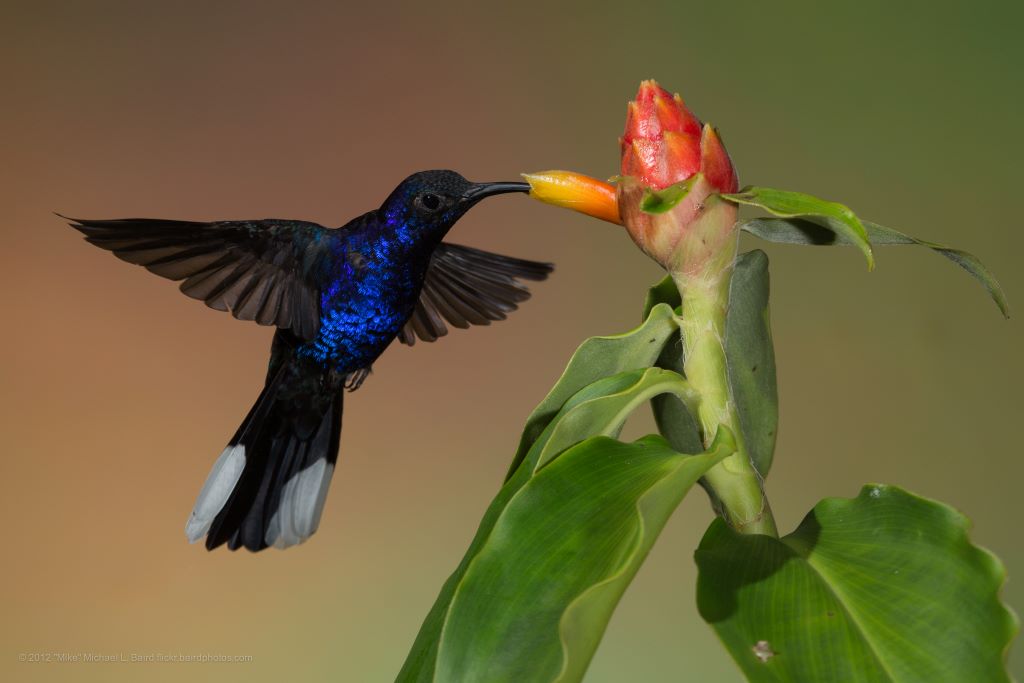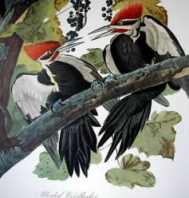The following topics are available as condensed “lectures” in ornithology for the general public:
Avian community, Avian Ecology, Biogeography, Development, Evolution, Feathers, Flight, Foraging and Nutrition, Metabolism and Thermoregulation, Migration and Navigation, Reproduction, Respiration and Circulation, Songs and Calls, Senses and Nervous system, and Territoriality.
 Violet Saberwing Hummingbird, Campylopterus hemileucurus
Violet Saberwing Hummingbird, Campylopterus hemileucurus
These “lectures” are based upon the university level ornithology course the ornithologist taught for many years. The information comes from many sources and are meant to give the reader a beginning knowledge of the science of Ornithology. As such, they are necessarily brief and incomplete. Much of this information has been gleaned from textbooks, journals, websites and science-oriented magazines. Additional information and research studies can be found elsewhere in this website and at links in these lectures.
INTRODUCTION
Birds, of all animals, offer the most favorable combination of attributes for scientific study. They are numerous, diverse, and easily observed in the field. Many also adapt easily to experimentation in the laboratory. So its easy to see why Ornithology, the study of birds, has so many practitioners and has contributed so much to the sciences of ecology, evolution, distribution, behavior and others. Bird watching and identification are essential parts of ornithology but by no means all.
Especially in ecology have birds been the focus of study. A number of ecological principles have been determined or refined by ornithological studies; e.g.niche segregation, island biogeography, character displacement, adaptive radiation, territoriality, communication, the effects of environmental degradation, and indicator species (e.g. the spotted owl). These same principles apply to other organisms but in many cases birds served as the original models for the studies that developed these principles.

By the 16th and 17th centuries a system of classification was used based on birds’ behavior: swimming, fly fast, catch prey with talons, etc. An early classification of birds appeared in 1676 and divided birds on the basis of both anatomy and behavior. This classification does not work, of course, because it is too simplistic and had little to do with real relationships. As centuries passed, so did classification schemes. These schemes relied moreon morphology and less on behavior. Taxonomy (classification and naming) was generally a mess until Linneaus published Systema Naturae in 1753 which set down a system of classification for all organisms.
FOR BIRDS:
Kingdom Animalia
Phylum Chordata
Class Aves
Subclass Archeornithes : Archeopteryx
Subclass Neornithes: all other birds
Order -iformes
Family -idae
Subfamily -inae
(Tribe -ini)
Genus
Species
Subspecies, races, etc.
For example, the Rock Dove, our city pigeon, belongs to the Order Columbiformes and the Family Columbidae. The genus is Columba and the species livia. Note that both the genus and species are italicized and that the genus is capitalized. And notice that species is always species, never specie.
Columba livia- Rock Dove
Common names of birds in North America are standardized by the American Ornithologist‘s Union Checklist of North American Birds
The International Ornithological Union World Bird List standardizes English names for all birds in the world
The definition of a species is based on the ability to interbreed. This is sometimes hard to determine leading to the Scrub Jay once being called the Santa Cruz Jay, the Santa Catalina Jay, and several other variations when one name was appropriate. For example: Western Scrub-Jay is now split into two species: the California Scrub-Jay (Aphelocoma californica) and Woodhouse’s Scrub-Jay (Aphelocoma woodhouseii). Birders have long recognized that these widespread western jays come in different flavors: a darker, more rich color in California, Oregon, and southwestern Washington, and a somewhat paler, grayer type in the interior West, from Nevada east to Texas. Many field guides already illustrate them separately as “coastal form” (or “Pacific form”) and “interior form.” They do hybridize where their ranges come together in western Nevada, but studies have shown that such interbreeding is very limited. So now they will be officially recognized as separate species.
Past taxonomy has been based on morphology, behavior, habitat, nest characteristics, etc., but most recently DNA hybridization techniques have been used with probably the most accurate results of any method.
What are birds? There are about 10,000 species of birds in about 170 families with 1 to 300 birds per family. When one looks at modern forms of birds only, birds form a homogeneous and distinct group, compared to the other vertebrate classes.
Birds are characterized by:
1. Feathers
2. Homeothermy
3. Laying of eggs
4. Lack of teeth; epidermal covered bony beak.
5. Pneumatic bones.
6. Adaptations for flight (about 123 flightless)
a. lightness
b. streamlined
c. centralization of weight
d. efficient metabolism
e. visual acuity
f. motor development of brain
Orders of Birds of the World
Ornithologists are both professional and amateur, but most professionals, about 80%, work on some aspect of the ecology of birds (rather than physiology, anatomy, etc.) This is primarily because birds are so easy to study in the field and harder to keep in the lab than other vertebrates. Much of what we know about the physiology of birds is based on work on chickens, pigeons, and house sparrows.
Although much of the recent ornithological research is ecological, the emphases are in areas such as populations (movement, decline, increase), metabolism in the field, genetics, taxonomy, effects of environmental changes on birds, and the fossil record.
The set of birds in any defined area is called the avifauna. The diversity of the avifauna is dependent both the climate and vegetation structure, primarily. Tropical forests have the highest bird species diversity and the tundra and open ocean the lowest. The only place where there are no breeding birds is the center of Antarctica. In North America, excluding Mexico, there are approximately 775 breeding bird species.
The spatial distribution of birds is due to the adaptations of birds – they are adapted to particular habitats. The temporal distribution of the birds is essentially one of migration. Classically, migration is a north-south oriented movement between a breeding and wintering range. But migrations may be very short such as down the slope of a mountain to a lower elevation (vertical migration).
Birds can be conveniently categorized by their migratory or non-migratory status in an area.
a. Residents: those birds that do not enter or leave the state/country/area during migration. Generally, these birds do not move very far during their lifetime.
b. Transients: migrate through in the spring and/or fall but do not nest in the area. Some are pure transients that merely pass through.
c. Winter visitors: are those birds whose breeding range is somewhere north.
d. Summer visitors: are those birds whose winter range is somewhere to the south.
e. Perennial visitors: are those of which individuals are always around.
f. Casual visitors and accidentals (occur unexpectedly). The remaining 6% defy categorization.
Kingdom Animalia
Phylum Chordata
Class Aves
Subclass Archeornithes : Archeopteryx
Subclass Neornithes: all other birds
Order -iformes
Family -idae
Subfamily -inae
(Tribe -ini)
Genus
Species
Subspecies, races, etc.

Common names of birds in North America are standardized by the American Ornithologist‘s Union Checklist of North American Birds
The International Ornithological Union World Bird List standardizes English names for all birds in the world

1. Feathers
2. Homeothermy
3. Laying of eggs
4. Lack of teeth; epidermal covered bony beak.
5. Pneumatic bones.
6. Adaptations for flight (about 123 flightless)
a. lightness
b. streamlined
c. centralization of weight
d. efficient metabolism
e. visual acuity
f. motor development of brain
My name is Grace. I’m a senior in high school this year and I’ve loved birds since I was a kid. My grandma’s kitchen window looked out on her flower garden, and she would point out the different birds to me and tell me about them. I just wanted to say that I appreciate this site. In honor of my grandma and due to my own fervor, I’ve decided to pursue the study of birds in my own time.
– Grace MacPherson
That’s nice to know, Grace. Thank you.